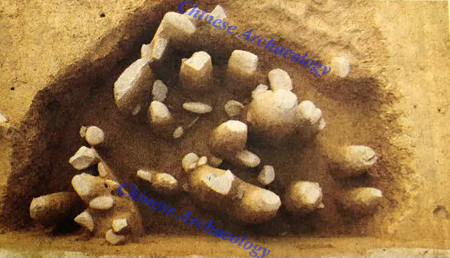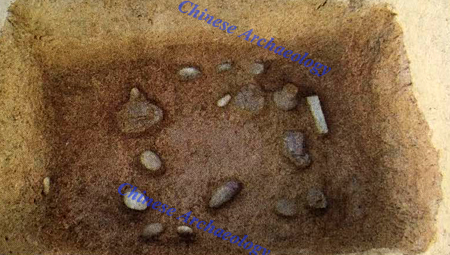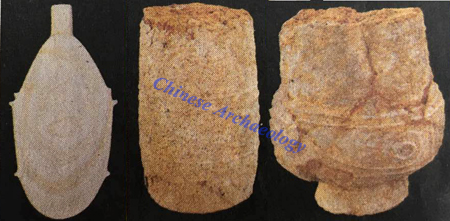DepthReading
New type of Macro-stone-spade culture found at Lilao site, Guangxi
Summary: The Lilao site was excavated from 2015 September, to 2016 January by the archaeological team from the Guangxi Provincial Institute of Cultural Relics and Archaeology. The excavation covered an area of some 600 square meters. Pits, ditches and burials were
The Lilao site was excavated from 2015 September, to 2016 January by the archaeological team from the Guangxi Provincial Institute of Cultural Relics and Archaeology. The excavation covered an area of some 600 square meters. Pits, ditches and burials were the three major types of features, dating to the late Neolithic.

Burial objects in tomb M1 and M2
10 pits have been recovered so far, most of which were oval in shape. Occasionally there were discoveries of square-shaped pits. Grey brownish sandy soil filled most pits. A considerable number of stone spades, stone cores, stone fragments, pottery shards and red burnt earth were found deposited in pits. Lithic wastes were clustered in the area where lithic spades were produced. Those pottery shards are very fragmental, among which fu caldron and cup could be recognized.

Distribution of the stone spade in ash pit H6
There is only one ditch circular distributed with gray brownish clay and quantity of charcoal dusts, red burnt earth etc.. Unearthed relics are relatively rich including incompletely stone spades, stone fragments, gravels, stone hammers and pottery fragments. Stone spades clustered in some areas speculating to be a workshop for producing stone spades.

Stone spade pieces in ash pit H10
3 burials were found, all of which were rectangular earth shaft pits. Burial M1 and M2 were arranged in parallel, probably suggesting their connection with each other. Burials were generally small in size, of which the length was around 1.6-1.7 m, width 0.8-1m and depth 0.57-0.8m. Neither skeleton nor coffin has been recovered. M1 had the richest collection of grave goods. Grave goods were arranged in three layers, the first layerof which was placed in the middle of the tomb chamber, containing 2 ceramic cups, 1 ceramic pot, 1 cup-shaped vessel, 1 stone core, 1 whetstone along with stone and pottery fragments. The second layer was deposited in the south of the tomb chamber where only one pottery cup was found. The third layer of grave goods was located at the bottom of the tomb containing 4 pottery cups, 1 jar with high neck, 12 pebbles and 1 raw material to produce spade. In burial M2, all grave items were located at the bottom. A large proportion of potteries were relatively fragmental, among which cup and jar were vaguely identified. In total 9 pebbles were found along with a spade raw material. Grave goods were placed at both ends of the tomb in M3. In the south lied 1 pottery cup and several pottery fragments while in the north 1 large pebble was discovered.

Burial objects in tomb M1
The archaeological assemblage at Lilao largely comprised of pottery and stone artifacts. Stone had the largest proportion, including spade fragments, wastes, hammers, grinding stones, hand axes, chopper and so forth. Only one spade was preserved completely. Very likely it was an item used associated with ritual ceremonies. This was the first discovery of this type of archaeological remains in the Guangxi Province. pottery types include fu caldron, cup and pot. Some of them were decorated with cord or cloud patterns.

Left:stone spade Middle:pottery cup Right:pottery pot
It was the first time that burials appeared in the sites belonging to the macro-lithic-spade culture. Although so far none complete spade was found buried as grave goods, spade blanks were instead deposited in tombs. Beside, pebbles were found in tombs in a large number. This tradition was retained among the Yue people till as late as the Han Dynasty. Therefore, the Lilao site might have had close connections to the ancient Yue people.
The Lilao site is the only site at the Baise Basin, Guangxi province that displays characteristic traits of macro-lithic-spade culture. The remains typology demonstrates a distinct style in the spade. As lithic spades there were distinguishable in the style and elaborately produced, they might have been used as ritual items. This type of spade was absent in other sites previously excavated. The pottery cup and pot, especial cylindrical cup were the first discoveries in Guangxi prehistoric archaeology. The discovery of cloud complex pattern at the Lilao site, however, challenges the conventional view previously perceived as lacking elaboration, being evident to illustrate the skillfulness of craft production. Taken all these lines of evidence into account, it is very likely that the Lilao site stands for a new sub-type of the macro-lithic-spade culture in the Guangxi Province. (Translator: Dong Ningning)

Burial objects in tomb M1 and M2
10 pits have been recovered so far, most of which were oval in shape. Occasionally there were discoveries of square-shaped pits. Grey brownish sandy soil filled most pits. A considerable number of stone spades, stone cores, stone fragments, pottery shards and red burnt earth were found deposited in pits. Lithic wastes were clustered in the area where lithic spades were produced. Those pottery shards are very fragmental, among which fu caldron and cup could be recognized.

Distribution of the stone spade in ash pit H6

Stone spade pieces in ash pit H10
3 burials were found, all of which were rectangular earth shaft pits. Burial M1 and M2 were arranged in parallel, probably suggesting their connection with each other. Burials were generally small in size, of which the length was around 1.6-1.7 m, width 0.8-1m and depth 0.57-0.8m. Neither skeleton nor coffin has been recovered. M1 had the richest collection of grave goods. Grave goods were arranged in three layers, the first layerof which was placed in the middle of the tomb chamber, containing 2 ceramic cups, 1 ceramic pot, 1 cup-shaped vessel, 1 stone core, 1 whetstone along with stone and pottery fragments. The second layer was deposited in the south of the tomb chamber where only one pottery cup was found. The third layer of grave goods was located at the bottom of the tomb containing 4 pottery cups, 1 jar with high neck, 12 pebbles and 1 raw material to produce spade. In burial M2, all grave items were located at the bottom. A large proportion of potteries were relatively fragmental, among which cup and jar were vaguely identified. In total 9 pebbles were found along with a spade raw material. Grave goods were placed at both ends of the tomb in M3. In the south lied 1 pottery cup and several pottery fragments while in the north 1 large pebble was discovered.

Burial objects in tomb M1
The archaeological assemblage at Lilao largely comprised of pottery and stone artifacts. Stone had the largest proportion, including spade fragments, wastes, hammers, grinding stones, hand axes, chopper and so forth. Only one spade was preserved completely. Very likely it was an item used associated with ritual ceremonies. This was the first discovery of this type of archaeological remains in the Guangxi Province. pottery types include fu caldron, cup and pot. Some of them were decorated with cord or cloud patterns.

Left:stone spade Middle:pottery cup Right:pottery pot
The Lilao site is the only site at the Baise Basin, Guangxi province that displays characteristic traits of macro-lithic-spade culture. The remains typology demonstrates a distinct style in the spade. As lithic spades there were distinguishable in the style and elaborately produced, they might have been used as ritual items. This type of spade was absent in other sites previously excavated. The pottery cup and pot, especial cylindrical cup were the first discoveries in Guangxi prehistoric archaeology. The discovery of cloud complex pattern at the Lilao site, however, challenges the conventional view previously perceived as lacking elaboration, being evident to illustrate the skillfulness of craft production. Taken all these lines of evidence into account, it is very likely that the Lilao site stands for a new sub-type of the macro-lithic-spade culture in the Guangxi Province. (Translator: Dong Ningning)
Category: English
DepthReading
Key words:
